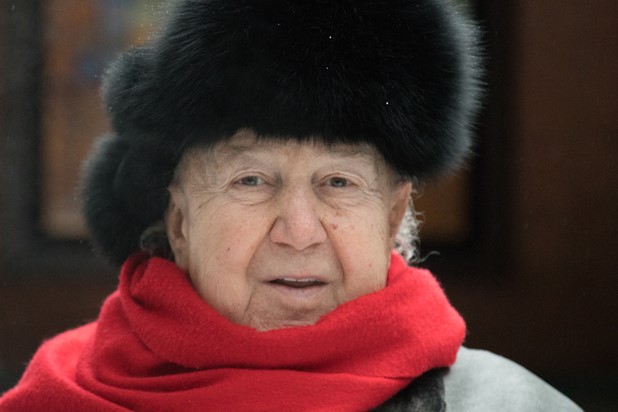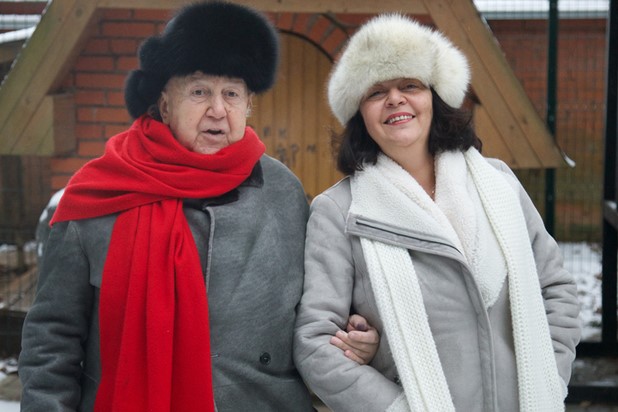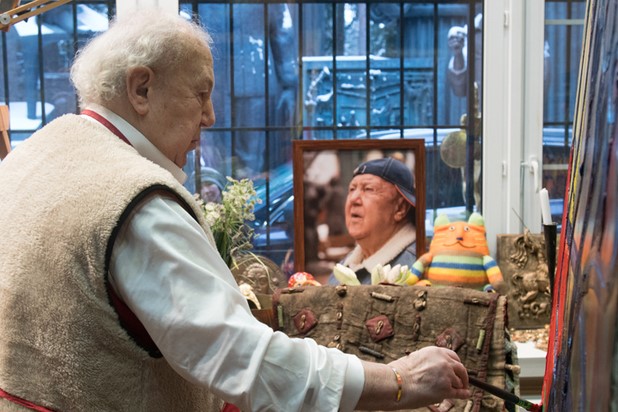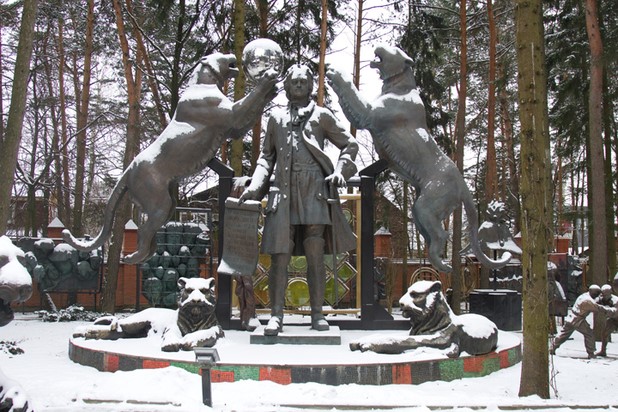Zurab Tsereteli at 85: “I draw and sculpt the people I adore”
The President of the Russian Academy of Arts on the eve of his birthday
The president of the Russian Academy of Arts has an important date coming up: his next birthday will be his 85th. And you might well say: “I don’t believe it!” The day’s schedule for Zurab Konstantinovich, knocking on the door of 85, looks like this: chairing an important meeting of the presidium of the Academy, receiving and listening to art historians from all over Russia, holding a master class for children, and attending someone else’s birthday party.
Where does he get the energy? We talked to Zurab Tsereteli ahead of his birthday to find the answer to that question. We also learnt much of interest about weight lifting, the eyes of loved ones, and the colours of faith, hope and love.
– Zurab Konstantinovich, how old do you honestly feel?
– Twenty-three. Really, it’s true. I run, play football and lift a barbell as well now as I did then. I work from morning till night, painting. I live the same life now as I always did.
– You really play football?
Of course. As soon as the art historians’ seminar is over, I will head to Peredelkino and have a game of football. There are people there to play with.
– Could you tell me the weight of the barbell? How much do you lift at a time? Do you do bench press or standing…military press, I think they call it?
I do weights every morning. I lift about ten times, lying and standing. I lift about 60–65 kilograms. It really helps me. My body is used to it.
– In my life I have been lucky enough to meet two people with that amount of energy – Oleg Tabakov and Zurab Tsereteli. Tell me, where do you get it from?
I get it from the people around me, from my daughter, my grandchildren, my great-grandchildren. From their eyes, their faces, their kindness – they keep me up to the mark. I live like them. Before that I had my wife, my parents, grandparents, uncle…
I did my first drawing with my uncle. He took me to the zoo. I drew, and my uncle watched, without saying anything. He didn’t interfere. He just watched to see where my hand and my brains were going, and helped me to convey the first impression correctly.
All the artists I love worked like that- they conveyed the first impression. In my gallery I have sculptures by Malevich and Kandinsky. I will have Leonardo da Vinci and Michelangelo too. Classic and avant-garde side by side.

Zurab Tsereteli (photo: press service)
– Coming back to energy, people who know say that everyone can be divided into two sorts: there are “donors”, people who give life energy to others, and there are “vampires”, people who suck up energy. Do you sense people who are “vampires”, who suck up energy from you?
No, I have never felt that. Maybe, because I have plenty of energy – enough to spare. Vampires … I don’t live like that. I get up in the morning, take a shower, do physical exercises, do weights and head for the studio to paint, or I run over to the Academy.
– I like that – you “run over” to the Academy.
I run over there. That’s my life. Just now at the seminar there were 88 art specialists from all over the country. I talked to them as intelligently and calmly as I could. I want them to be as useful as they can be for the new generation. Most of all I want them to work for the creation of museum collections. Not salons, not galleries, but museums. Museums are Russia’s wealth.
– Do you think they heard what you were saying?
Of course they did.
– When do you relax?
When it’s time to work, I work. When it’s time to relax, I… also work. When I am painting, I forget where I am, the world feels to me like the rooms in my home.

– Zurab Konstantinovich, you have lived for many years in Moscow. With its hard-nosed attitude to life, isn’t Moscow a tough place for a free-and-easy Georgian?
No, Moscow is my homeland, as much as Georgia. I love Russia, I love Georgia and I love people. Georgia brought me up and gave me a lot. Delight in life is fundamental to the Georgian character. But the country also taught me to love God and my neighbour.
– You are a wonderful painter and colourist. Do you view people, life and ideas in terms of colour?
I am a colourist myself and I adore the power of the sun, I adore nature and the eyes of the people I love. And when there is no sun, then, of course, there is a tonal attitude towards life,towards people. But I still look for colour: I take flowers, sunflowers, and I draw them. I love being given flowers – I always draw the flowers I am given. Why? Because in Moscow there are a lot of grey days in the winter, there isn’t much sun, and I draw flowers to keep in touch with colouristic, tonal relations. Flowers have all of that.
– Suppose we talk about love, what colour is it for you?
Bright, like sunflowers.
– And hope?
Like the sun, with reddish tints.
– And faith?
Yellow and red together. Faith has an amazingly bright colour!
– What a palette! When the great English artist,Turner, came back from Italy, he also painted everything in a multitude of orange-yellow colours and tones. What is the colour of evil? And of money, the root of all evil?
Evil is black. As for money, I haven’t thought about it – it’s an interesting idea.
– You often draw your contemporaries. How do you choose? Why some and not others? What must one do to be the subject of a portrait by Zurab Tsereteli?
I draw and sculpt the people I adore. I adore my parents who have deported this life, I adore children, the beauty of nature, beautiful, good people, beautiful women. On the first floor of the gallery there is a hall of bas-reliefs and sculptures of my contemporaries. I knew all of them, respected them, valued them, loved them and still loved them. And there is a whole hall devoted to portraits of Charlie Chaplin. He, for me, was the most talented, wisest, most adaptable person – not like anyone else. A giant! I haven’t painted anyone as much as I have painted him, because – I say it again– he isn’t like anyone else! He has his own philosophy in the way he walks, in his movements, his eyes. I adore him.
The artist sees what ordinary eyes can’t see. The colour scheme, colour relationships and a lots of other things. When I look into a person’s eyes, I want to convey their inner state on canvas. If anew person comes to me and I don’t know them, first I look at them as a whole,their outline, image and eyes. Everything is there in the eyes – the state of their inner life. I look and remember, because tomorrow, or the day after, everything about that person will be different.

– Your house and home is the Academy of Arts, to which you have effectively given new life, restarted the engine, reformatted it in many ways, opened the doors to artists with different orientations. What are the main house rules?
My house lives by one main rule – to preserve Russian culture and art. Then to educate the new generation, which, in turn, will create objects that deserve to belong to museum collections for future generations. And finally, that academicians should walk through life as young people, not as old people. That’s in a figurative sense – their hands and their thoughts should work like those of young people.
– Like Zurab Tsereteli?
We have good artists. Russia is rich in that respect.
– You described guiding principles. But what are he staff rules in this academic house?
The first is kindness, love of art, and giving more than you receive.
– Is that the criterion you use when you choose people to employ?
That’s the criterion. It’s the same criterion that I live by myself. I am the president of the Russian Academy of Arts. My idea is that you need to give knowledge and know-how to the younger generation.It’s more important to love and to give than to take from life. I want to move away, just a bit, from the egoism that exists and prevails today, especially in Moscow. I told all of the academicians: share your experience with schoolchildren and with students. I started to do that myself a long time ago, when I was still in Tbilisi, where I organised workshops for children, and then in Moscow, when I moved here with my family. I really enjoy working with children.
Children see how I work, they look at what do and they paint themselves. I like to watch them: I see that the boy in front of me has no colour range in his painting, but I can already see that the girl will be good at graphics … I don’t often use words when I teach, it’s not in my character. I say to the children: “If you like to work, you can achieve something. But if you say ‘I’ll rest today and work tomorrow’, you won’t get anywhere.”
– In your work, have you ever come up against restrictions of your personal, that is, your creative freedom?
I feel absolutely free. If something gets in my way, I walk away from it. I do art. The Academy is art, it’s creativity.I don’t know what it means not to be free.
– Imagine the impossible: Zurab Tsereteli meets Leonardo da Vinci. What question would the president of the Russian Academy of Arts put to the great Leonardo?
I would ask: “What do you think of Zurab’s work?” Don’t laugh, I mean it. I would ask what he thinks of my sculpture, of my painting.
– What if he said: “I’m not very keen on your sculpture”. What would you do?
Well, I would go away and think about why he didn’t like it.

– And what would you ask your main teacher, the Russian artist Ivan Shukhaev?
I would show him my recent works and ask,“What do you think?” And he would say what he would say. I have his portrait on he wall, I look at him every day.
How did Shukhaev teach? He said: “If you can’t draw, you won’t be an artist. Study anatomy first of all.” I’ll tell you what he used to do: he put ten easels with blank paper in front of the students, and a nude model behind the students. We looked at her once and started drawing, without ever looking again. Shukhaev said: “You will thank me for making you draw from memory.” You remember character better that way, you grasp the form, the volume and what you convey on the paper is what is most important.The chief commandment of my teacher was: freedom in practice is more useful than any theory.
– Another question, in the subjunctive mood. If you, as president of the Academy of Arts, were to be elected president of Russia, what would be the first law or decree you would sign?
I would unite all nations, all the nations of Russia. All those who love Russia. Russia is a kind and good country with good people, but some of them have their faults… I won’t go into detail.
– And what would they all call themselves – citizens of Russia?
This is for them to decide. But I would bring them all together and give them all the same passports, so they would be in a single land without borders. Maybe the former republics of the Soviet Union would come in as well.
– What advice would you give to people who find it difficult to live now?
To love nature, their land and their neighbour.
– Do you think that will help?
Certainly it will help. I am a believer, I have made 64 illustrations for the Bible and I affirm that every nation should know its Bible. Then there will be happiness. And the nation will follow the right course. The Bible helps me.
– Are you a dreamer?
I certainly am!
– What do you dream of today?
I dream of being able to work with no-one disturbing me and of more sun. The sun has a good effect on me. I sing when I paint. I don’t even notice myself doing it. People tell me I do it. When I am painting I don’t notice life, I don’t see what is happening around me. I am not here, I am there. And I feel good there. It’s paradise, like talking to God –that’s something I have known for a long time.
Interview by Marina Raikina
